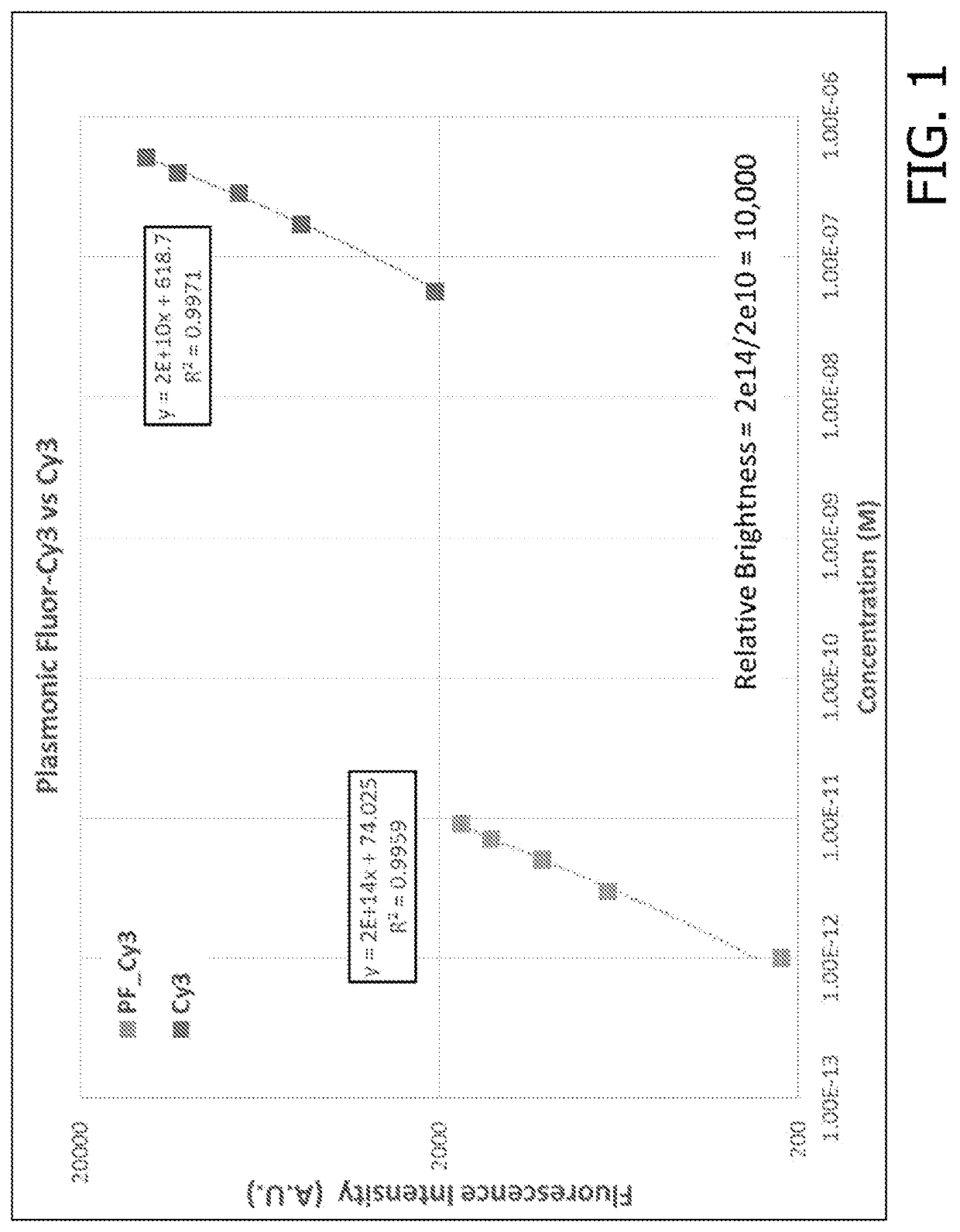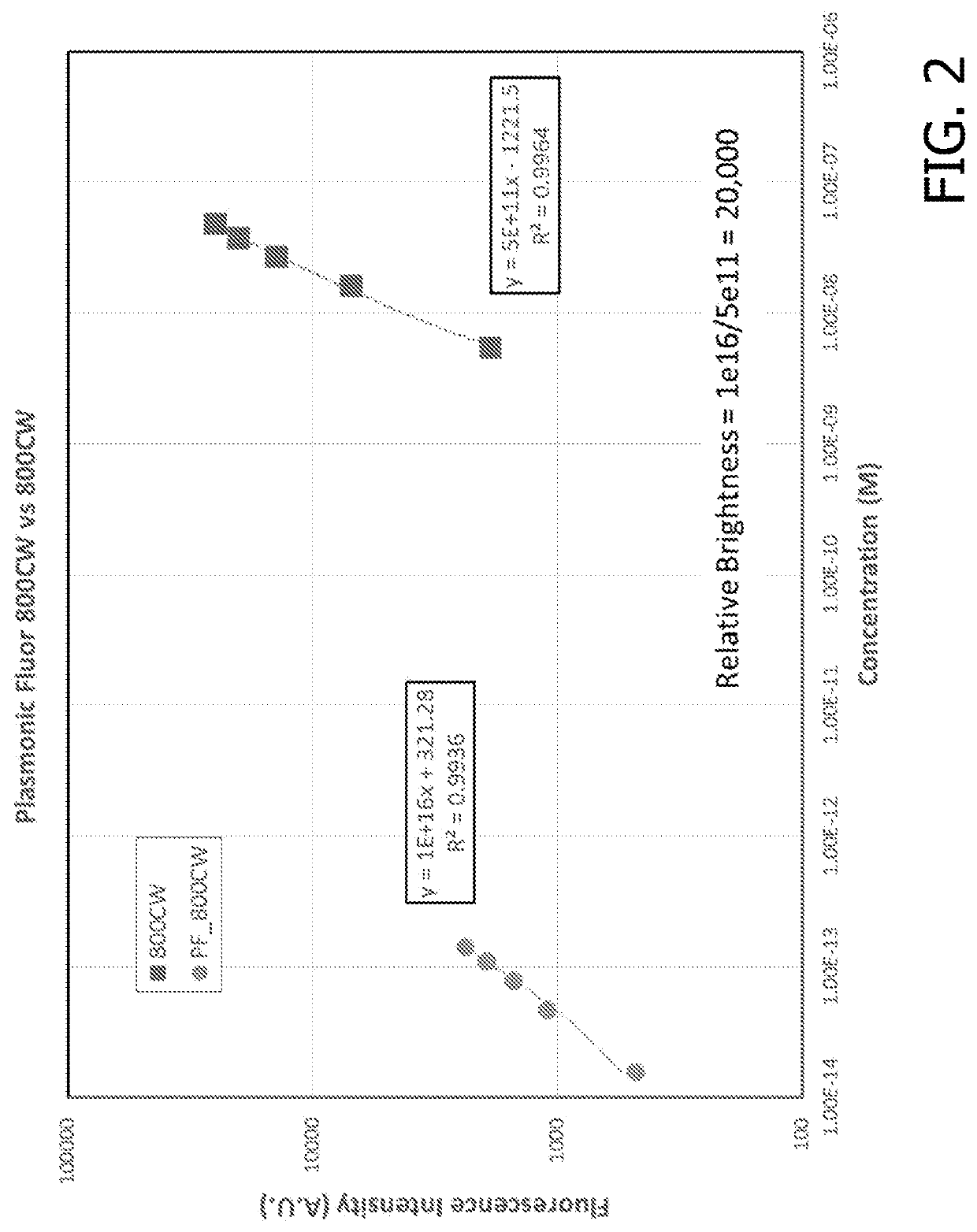Ultrabright fluorescent nanoconstructs as universal enhancers
a fluorescent nanoconstruct and fluorescent nanotechnology, applied in the field of ultraviolet fluorescent nanoconstructs and plasmonicfluors, can solve the problems of limited ultimate sensitivity of current fluorescence-based assays, use of special surfaces, and possibly significant alterations of read-out devices, and is not readily applied to a large variety of systems or bioassays
- Summary
- Abstract
- Description
- Claims
- Application Information
AI Technical Summary
Benefits of technology
Problems solved by technology
Method used
Image
Examples
example 1
[0213]In the design and synthesis of the fluorescent nanoconstruct, two factors require careful consideration: (i) the attached fluorophores must be far enough away from the plasmonic nanostructure surface to avoid metal-induced fluorescence quenching; and (ii) the fluorophores must be close enough to the plasmonic nanostructure surface to benefit from the enhanced electromagnetic field which decays rapidly as the distance from the surface of the plasmonic nanostructure increases. It is known that the evanescent nature of the enhanced electromagnetic field at the surface of the plasmonic nanostructures results in a highly distance-dependent enhancement of fluorescence at the surface of the plasmonic nanostructures. When fluorophores are brought in direct contact (or in extreme proximity) to plasmonic nanostructures, non-radiative energy transfer between the fluorophore and metal surface results in fluorescence quenching. On the other hand, increase in the distance between the fluoro...
example 2
idation
[0216]Following the synthesis of the fluorescent nanoconstruct, the application of these novel materials and novel approach was validated in several bioanalytical techniques to enhance the feeble fluorescent signal and the associated bioanalytical parameters. For comparisons of enhancements in assay parameters of commercially available assays described below, the assays were performed according to the vendor specifications and plasmonic-fluors were added at a concentration <10× the concentration of the gold standard reporter molecule. It is possible that even higher performance can be achieved by optimizing reagent incubation times and concentrations.
[0217]The plasmonic-fluor acts as an ultra-bright fluorescent probe in the last step of bioassays to enhance the feeble fluorescence and signal-to-noise ratio (SNR) without entailing any change or modification of the existing bioassay protocols (i.e. “non-invasive” method). The ultra-brightness of the plasmonic-fluor is due to th...
example 3
[0224]The ultrabright fluorescent nanoconstructs were also applied to cell imaging to probe and reveal cell surface biomarkers. A breast cancer cell line was selected as the model and probed for the over expressed biomarker ErbB2 using different dilutions of ErbB2 primary antibody, followed by 800CW labeled streptavidin. The experiment illustrates that after the addition of the biotinylated fluorescent nanoconstruct, the fluorescence intensity corresponding to the ErbB2 increased by up to 100-fold (FIG. 8A and FIG. 8B). The fluorescence microscopic image still reveals the overexpressed ErbB2 even at a primary antibody dilution of 105 fold (FIG. 8A). In practice, most users would use a PF attached to a secondary antibody or primary antibody for cell- or tissue-based experiments including flow cytometry, immunocytochemistry, and immunohistochemistry. By attaching the PF to antibodies, a user can more easily multiplex (i.e. detect multiple markers simultaneously by using specific antib...
PUM
| Property | Measurement | Unit |
|---|---|---|
| thickness | aaaaa | aaaaa |
| thick | aaaaa | aaaaa |
| thick | aaaaa | aaaaa |
Abstract
Description
Claims
Application Information
 Login to View More
Login to View More - R&D
- Intellectual Property
- Life Sciences
- Materials
- Tech Scout
- Unparalleled Data Quality
- Higher Quality Content
- 60% Fewer Hallucinations
Browse by: Latest US Patents, China's latest patents, Technical Efficacy Thesaurus, Application Domain, Technology Topic, Popular Technical Reports.
© 2025 PatSnap. All rights reserved.Legal|Privacy policy|Modern Slavery Act Transparency Statement|Sitemap|About US| Contact US: help@patsnap.com



